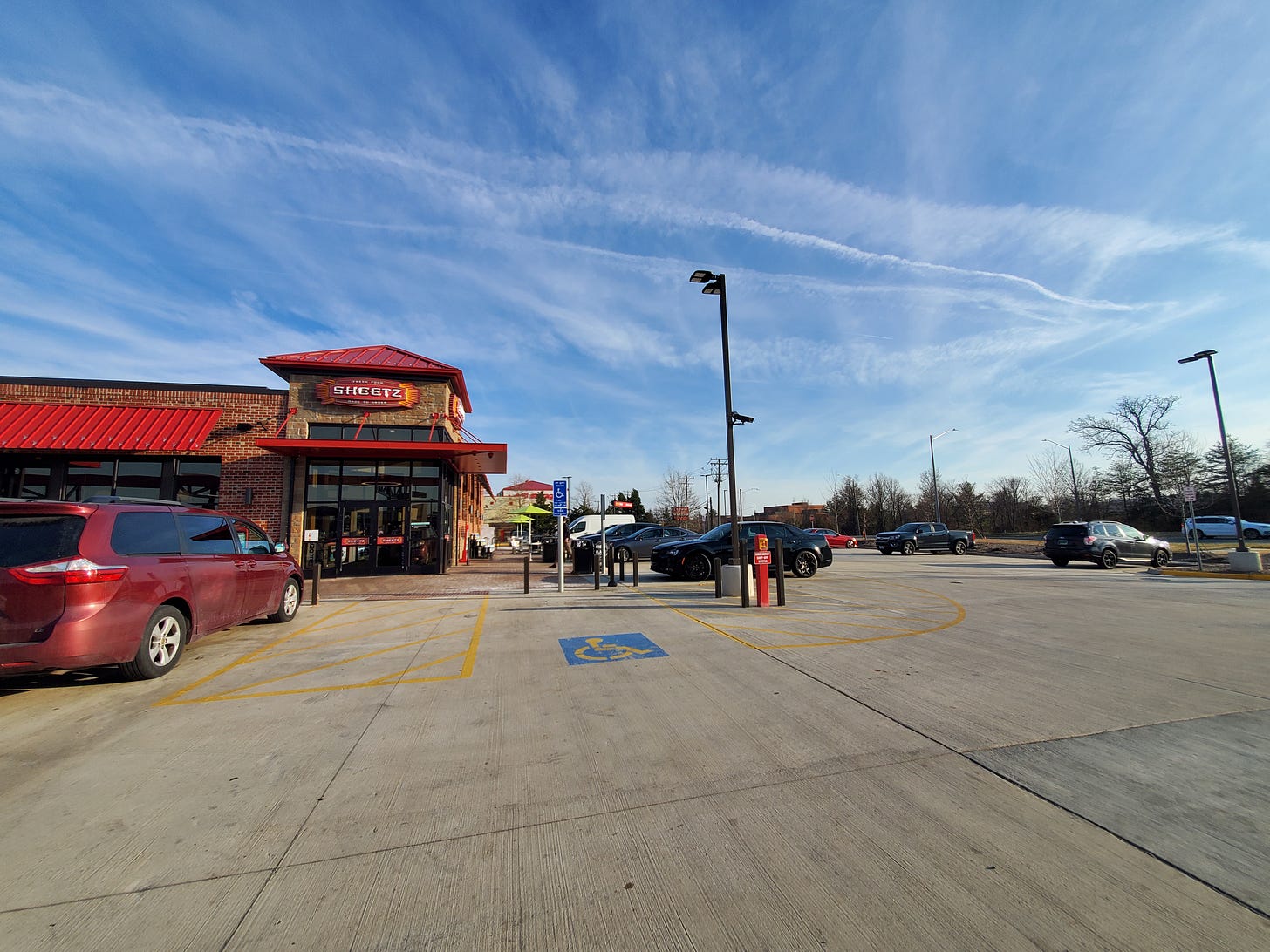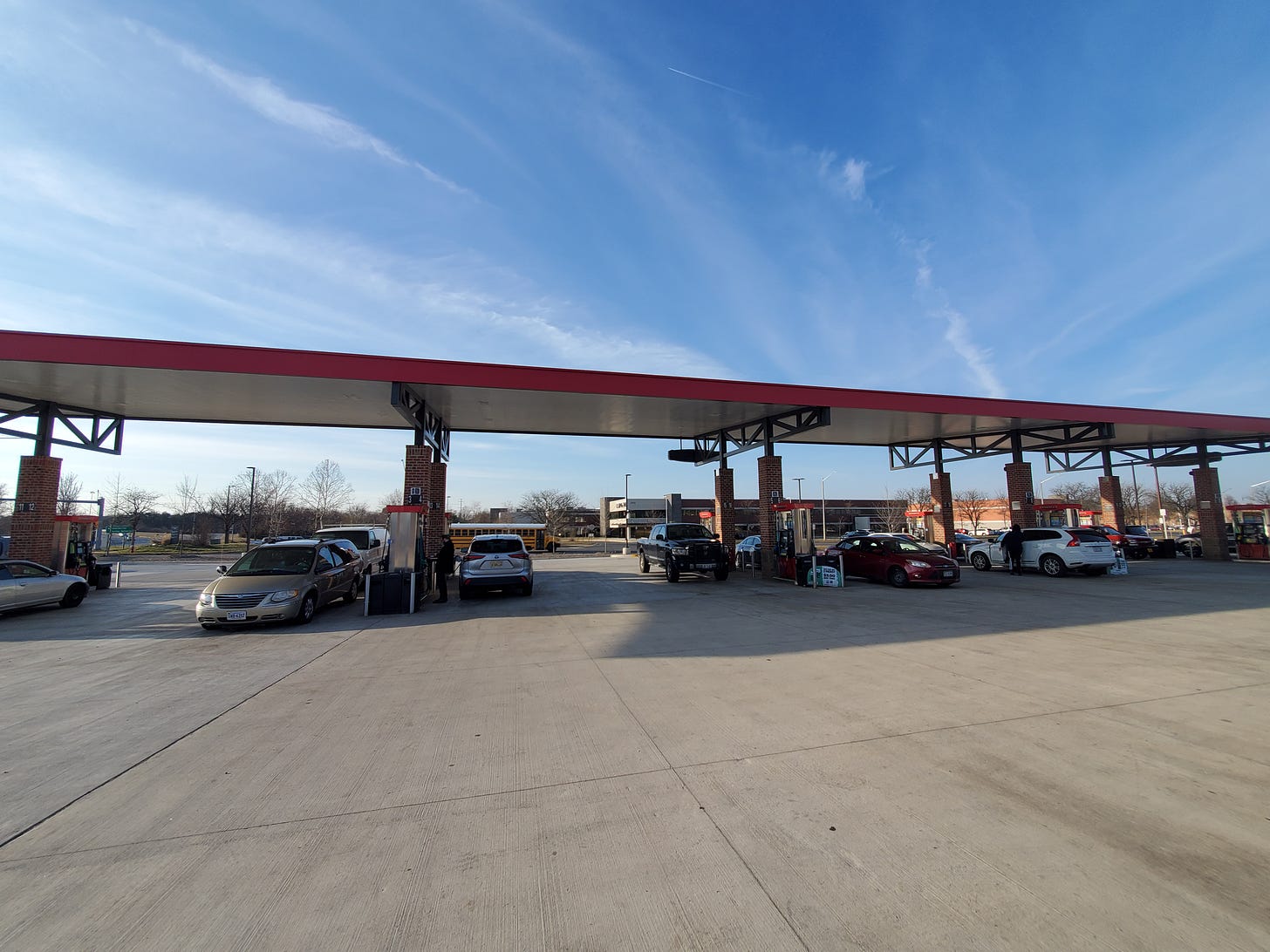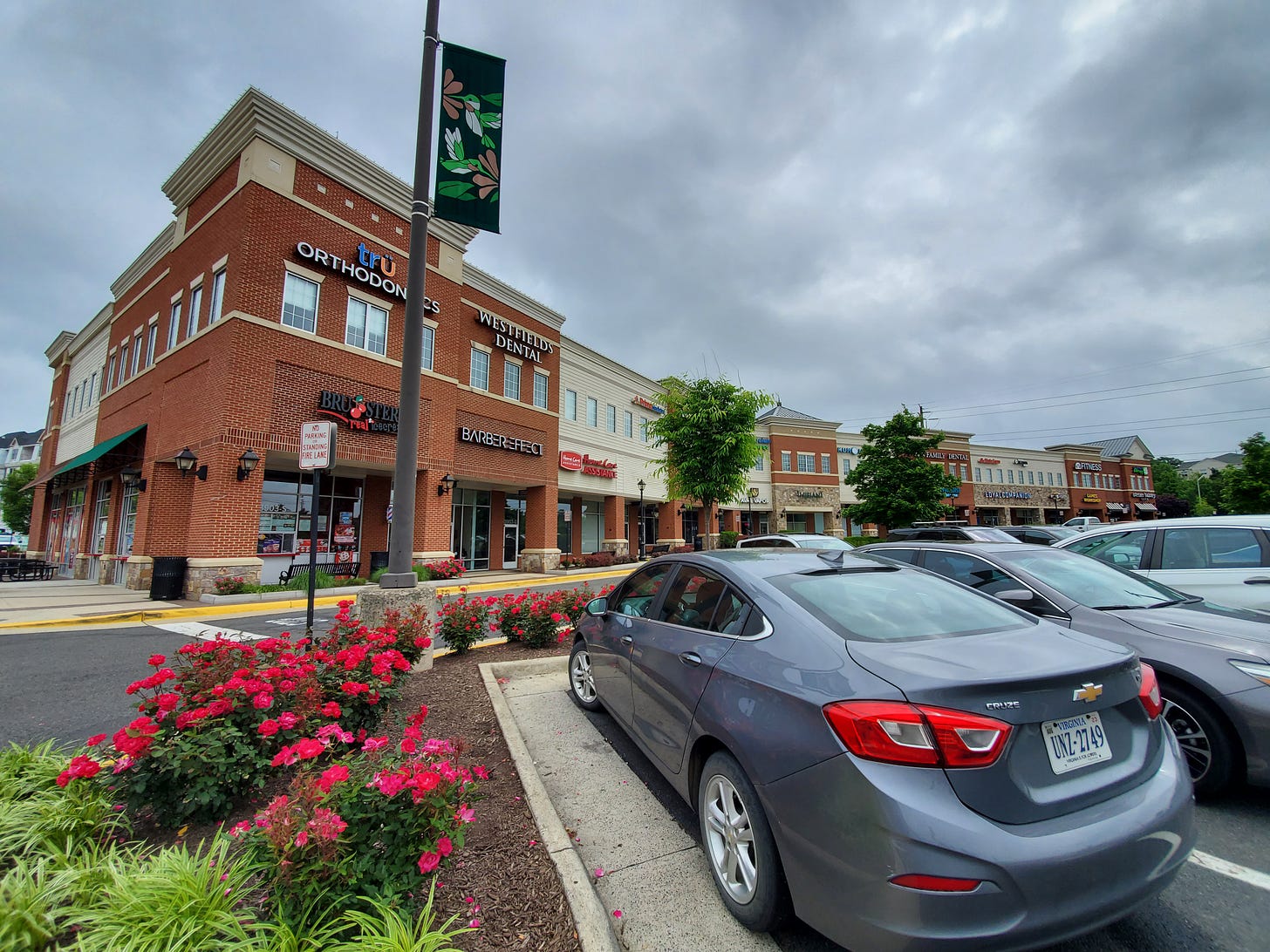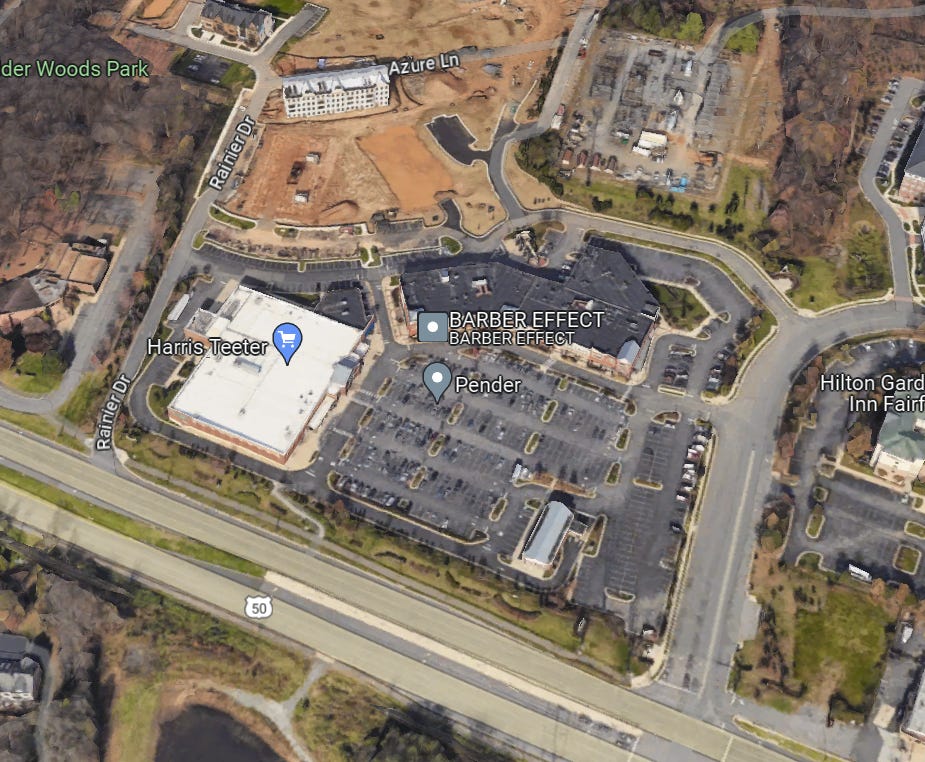I’ve been thinking about something lately.
The other day I drove to the new Sheetz gas station/convenience store/fast food restaurant that opened up a few minutes from our house. It’s a very large property; maybe two thirds of the pump spots were full. My immediate thought, something I felt before I even had a conscious thought, was “look how crowded it is!” It’s almost a feeling of panic that overrides your actual knowledge that at worst you’ll wait a minute or two to pull into a free bay.
My Sheetz, and any of the newer ones, looks like this:
I get a similar feeling of frustration-verging-on-panic when I go to my dentist and try to get in, park, and get out of the shopping center she’s in. (The actual dental appointment causes less distress!) It’s actually a nice shopping center: a supermarket, a few restaurants and stores, a rare second floor of mostly medical offices, and adjacent townhomes.
Here’s what it looks like from above (the houses aren’t there yet in this Google Maps view because they’re so recent!)
The thing that gets me? That one-way entrance at the left called Rainier Drive. I go in that way, park, do my thing, go back that way, throw up my hands as I remember that this isn’t the exit, and then have to navigate through the whole parking lot again to get out.
And as strip plazas go, this is a pretty good one! It’s superior to the same elements spread out, such that they can all only be accessed by car. Living within a two-minute walk of some everyday retail and services would be very nice. So maybe it’s my fault for driving.
But the nature of these large developments is that they have this effect of making you feel almost stranded. They make you feel small. That sense of frustration, disorientation, being thwarted and dwarfed by this big faceless thing, when you’re waiting for a gas pump or stuck in a grocery store line at a huge store or circling a vast parking lot. I can feel that it activates something in my brain, some feeling almost of danger, despite my knowing how silly that is. So I guess I’m saying these places feel crowded.
Now yes, of course, cities are crowded too. But they are crowded in a qualitatively different sense—perhaps even a physiologically different sense. We may not have precise language for this, but our brains know the difference. The bustle of a packed sidewalk does not entail the same unbearable frustration as being stuck in stop-and-go traffic or having trouble finding the exit from a parking lot. And most urban settings are not going to reach the constant bustle of Manhattan, in any case.
So the Sheetz gas station got me started on this, but what it really did was remind me of the little three-pump gas station in my hometown, which looked like this (the pumps have been pulled out and the property is probably going to be redeveloped):
We used to fill up here all the time when I was a kid. I don’t remember it ever being full. Why is the larger gas station, with more capacity, more full?
I think about my childhood, and how my local town and its surroundings came to feel more crowded over time. Part of that is marrying population growth with land use that turns every trip into a car trip. But part of it is also larger-scale businesses replacing smaller-scale ones. We need more density of stuff.
The big supermarket doesn’t always feel packed because there are “too many people.” It feels packed because it pulls people from a wide radius, instead of those people having, two, three, five, ten smaller options much closer to them. Those smaller enterprises, which don’t always need to be full, have enough spare room for customers from outside the natural trade area to visit sometimes. This is a huge element of why physically spread-out places full of big chain stores feel crowded, even when their population densities are relatively low.
Centralizing, concentrating, and “embiggening” things, and separating those things via distances convenient only to the car, conjures traffic and crowding out of nothing. As my wife put it, traversing the endless suburban sprawl around Durham and Chapel Hill in North Carolina, “it feels crowded for no reason.”
I think this is a big contributor to NIMBYism in the suburbs. When we hear new this or new that we can see and almost feel that frustration of the packed gas station or store or parking lot. That experience of constantly deteriorating ease of getting around and doing things is more or less what “density” or “new housing” means to suburbanites.
It reminds me of the scene with Vince Vaughn and Jennifer Anniston where the fictional movie couple is bickering over the dishes. Vaughn’s character gives in and huffs, fine, I’ll do the dishes. Anniston’s character goes, “I want you to want to do the dishes.” To which Vaughn replies, mystified, “Why would I want to do dishes?”
This is a really good distillation of how suburbanites think about new housing and development. We’re being told by these seemingly self-righteous housing people that we should welcome growth. The only frame of reference we have for growth is more traffic, more crowding, more of those frustrating situations. More of these large, overengineered properties where you can get lost or stuck or made to feel small. Why would I want development? Why would I want traffic? At best, absorbing new growth becomes a kind of sacrifice, something salutary but unpleasant. Eating your vegetables.
I was in Harpers Ferry a few weeks ago, and walked into a pottery studio. The proprietor was friendly and we chatted a bit (Harpers Ferry, like my hometown, has a historic hotel whose redevelopment took ages and ages. It’s a good conversation opener when I’m in a place with a similar long-running project). I told him I was from Fairfax and he said, “Oh, it’s crowded there.”
Is it? It’s not not crowded—a million people, after all. But Harpers Ferry gets quite crowded on nice-weather weekends, if not weekdays—it’s a daytrip destination for the D.C. metro area, not the middle of nowhere. But Harpers Ferry is granular and small-scale, like most old towns and cities.
We’ve broadly chosen the unfortunate word “crowded” to refer to places whose land-use patterns and commercial development generate car trips for almost every task and concentrate people towards a few large properties and enterprises. The answer is to break up that scale. Easier said than done. But first you have to say it, and I don’t think most of us are even there yet.
Related Reading:
The Neighborhood Supermarket Never Disappeared
Spread Out or Smashed Together?
Thank you for reading! Please consider upgrading to a paid subscription to help support this newsletter. You’ll get a weekly subscribers-only piece, plus full access to the archive: over 900 pieces and growing. And you’ll help ensure more like this!










IMO the phrase that best captures this is "human scale".
Human scale places can be crowded with people, but waiting at traffic lights or cruising for parking are inherently frustrating and anxiety-inducing. In a crowded place you're at least around other people, but trying to find the exit from a parking lot is just a waste of time.
More generally, the question of how to retrofit some semblance of organic, human-scale urban spaces onto the car sprawl suburban/exurban miasma is a very difficult one. Unless and until local governments get much more serious about deliberately planning walkable, appropriately-scaled towns, these sort of faux-urbanist mixed-use developments are the best we can hope for.
The usual urbanist hype!
If the problem is congestion, the urbanist "solution" is a "road diet" that eliminates passing lanes, forcing drivers into a single-file stop-and-go crawl -- and a "complete streets" approach that turns every street into an obstacle-course for drivers as it puts more pedestrians in harm's way (where they're nonetheless ostensibly less likely to get killed) -- and then adds dive-bombing two-wheeled gnats to the (oh-so-"vibrant") mix.
Moreover, we need to distinguish between the brutal massification of, say, a Costco, and the overall tapestry of suburban life. After all, the best mom-and-pop eateries are in those much-maligned (often smaller-scale) strip malls. Having a car puts a vast assortment of them at your doorstep -- assuming that you don't (on principle) hate to drive. What's so sacred about that dinner being accompanied by a walkable waddle? Especially when it comes at the price of living like "The Honeymooners" -- the appropriately-named Ralph and Alice "Crammed-in"?
Anyone who can't find their way in and out of a parking lot ought to listen to the Beach Boys' "Fun, Fun, Fun."
It's "sprawl" only when you're looking down on it.
PS: The true analogy for the anomie of those "big box" operations is with the massive old urban department stores (or a trip to a first-run theater downtown) -- and the jammed, screeching subway ride (on some remote planner's arbitrary, fixed route and schedule) that one must plan for and endure to get there and back (tightly bound to a timetable if one stays out late!). Is that truly what we need in order to have any semblance of a social life?
Perhaps there's no accounting for taste, but I'd rather hop in the car.